The Lemur leaf frog is known for its spindly body with a vibrant apple-green color. This arboreal species has giant eyes with vertical pupils. Though they are bright green or yellowish during the day to camouflage, the color changes to reddish brown at night.
Their eye color also changes to dark gray at night. This nocturnal frog species have thin arms and legs. No webbing is noticed in their forelegs or hind legs. The movement of lemur leaf frogs is comparatively slower, and they seldom jump.
Over 5,000 unique frogs are available in the world, and the lemur leaf frog is critically endangered. From habitat degradation to chytridiomycosis, they have multiple reasons behind population loss. Their conservation is important for human medical research and to maintain a balance in the local ecosystem. To conserve the species, knowing their habitats, behavioral patterns, conservation status, etc., are crucial.
In this comprehensive guide, we will focus on the physical characteristics, habitat, behavior, and conservation status of this species. You will also learn the reasons behind its population loss and how to conserve this species native to tropical rainforests in Central America. Before going into a detailed discussion, we will start with its classification.
Scientific Classification of Lemur Leaf Frog
The common name of this species is Lemur leaf frog or lemur tree frog. And the scientific name of this species is Agalychnis lemur.
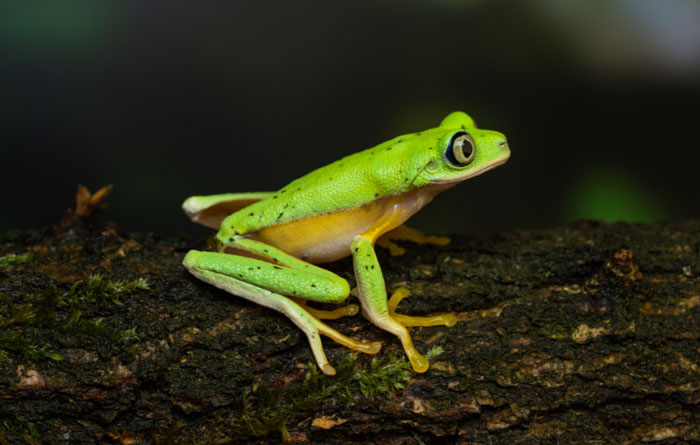
Here is the full classification of the lemur leaf frog.
- Kingdom: Animalia
- Phylum: Chordata
- Class: Amphibia
- Order: Anura
- Family: Hylidae
- Genus: Agalychnis
- Species: Agalychnis lemur
Physical Characteristics
The most interesting part of the lemur leaf frog’s physical characteristics is its bright appearance on a thin body. And those bulky eyes on this thin body make this species visually intriguing. Their feet are suitable for gripping tree brunches, and this Hylidae family is also known as the treefrogs family.
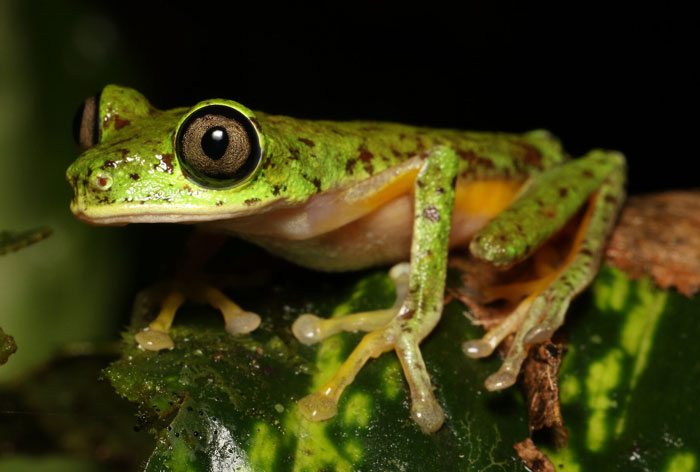
Size
The sizes of female and male frogs are different. Female lemur leaf frogs can grow up to 5 centimeters long, but the males won’t be more than 4 centimeters. The average weight of female lemur leaf frog is about 4 g. But male leaf frogs will weigh just about 2 g.
Coloration and Markings
Dark spots or flecks are visible on the back of lemur leaf frogs. And these spots are more visible because of their bright green coloration. When these frogs are young, they have a pale or lime-green color. But as they grow, the color changes to a bright green.

Though their back and the top part of the legs are bright green, the flanks and the bottom part of the legs are yellow or sometimes orange. And the belly is generally white.
You might already know that they have vertical pupils. But there is a distinct circle around the eyeball of lemur leaf frogs. The eyes protruding from the skull, which is beneficial for getting a better view of the surrounding.
Skin Texture
Lemur leaf frogs seem to have smooth skin from a distance. Don’t let that confuse you about their skin texture. If you look closely, the skin is grainy. And these grains are visible to bare eyes. There are no warts or tubercles on their skin.
Overview of Different Species of Lemur Leaf Frogs in Central America
The Agalychnis genus is known for containing tree frog species in Central and South America. About 14 lemur leaf frog species are present in Central America. Among these species, the following are the common ones.
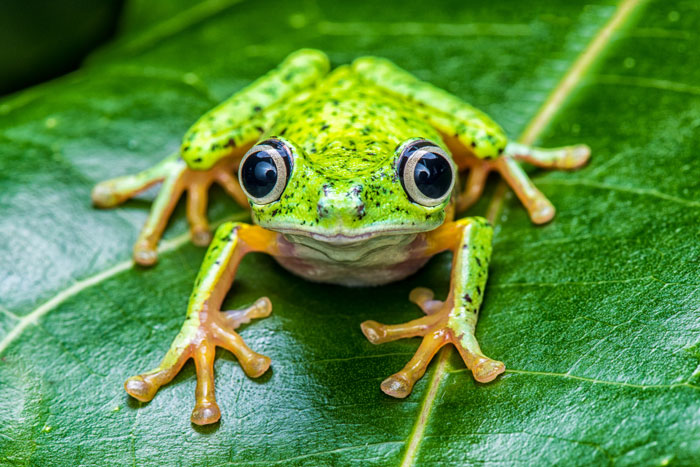
- Blue-sided leaf frog (Agalychnis annae): This is a slender frog and slightly larger than lemur leaf frogs. They are also known as orange-eyed leaf frogs.
- Warty leaf frog (Agalychnis buckleyi): The name comes from warts on their skin. These frogs are native to the neotropical regions in Ecuador and Colombia.
- Red-eyed tree frog (Agalychnis callidryas): This species is known for its vibrant color on all over the body and large red eyes. It has blue and yellow stripes on green with webbed toes.
- Gliding leaf frogs (Agalychnis spurrelli): It is also known as pink-sided tree frog due to the pink stripe on its sides. And the frog has slightly unusual locomotion methods compared to other species in the family.
Adaptations of Lemur Frogs
The most common lemur leaf frog habitat is the humid highland and lowlands in tropical rainforests. And their adaptations help them survive in their natural habitats.
- They have vertical pupils that help these nocturnal animals see better at night.
- Non-webbed feet are helpful for having a better grip on tree branches.
- Lemur leaf frogs can change their color from bright green or yellow during the day to reddish-brown at night.
- Their eyes also change color to dark gray so that they can hunt easily. And the bright color helps them camouflage during the day.
Habitat and Behavior of Lemur Leaf Frogs
The Lemur leaf frog is native to pre-montane rainforests in Costa Rica, Panama, and Columbia. In these regions, they prefer humid grasslands and forests as their habitats. These rainforest ecosystems are also known as the lungs of the planet.
They have tall, evergreen trees that face a large amount of rainfall every year. And they are the oldest living ecosystems on Earth. Especially, forests on sloping mountains are the most common lemur leaf frog habitats. They are also seen in freshwater ponds or wetlands.
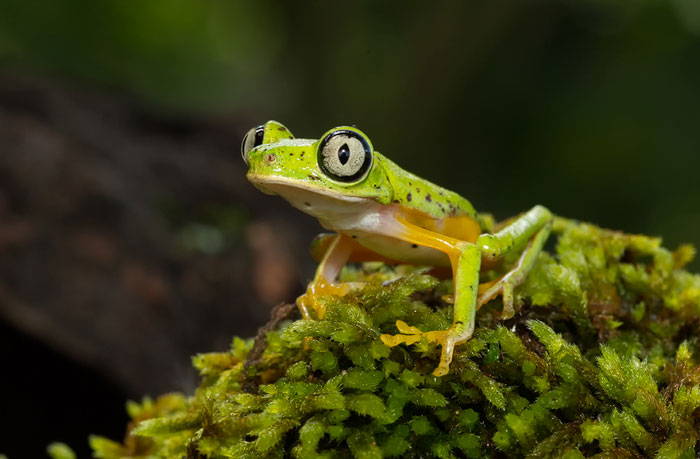
The standard elevation range of their habitats is between 440 and 1600 meters above sea level. Most of these frogs are native to three Costa Rican areas. These areas are Fila Asuncion, Parque National Barbill, and Guayacan. And the breeding population is highest in Fila Asuncion.
Different Behaviors Exhibited by Lemur Leaf Frogs
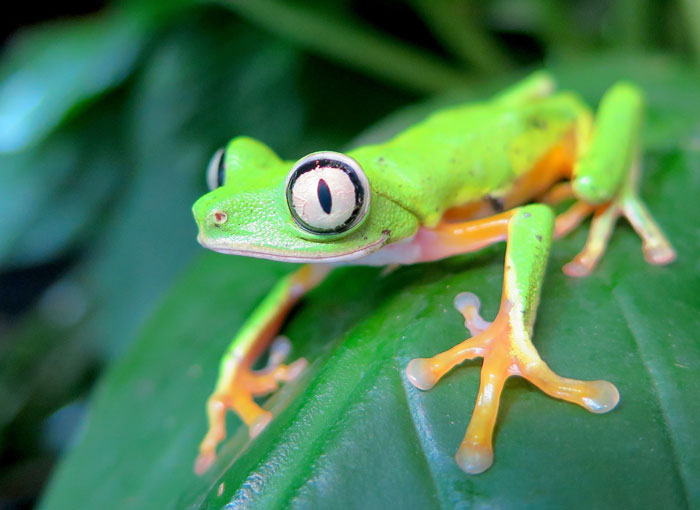
Here is a detailed overview of lemur leaf frog behavior.
Activity Patterns
Lemur leaf frogs are nocturnal, which means they are active at night. And they remain active throughout the year. But they can also be crepuscular, which means their activity starts right after dusk.
Locomotion
Lemur frogs are slow climbers, and they usually perch on leaves or twigs. They don’t usually hop unless it is an emergency. When hunting, they approach the prey slowly.
Social Structure
Lemur leaf frogs usually live alone. And territoriality is a common lemur leaf frog behavior.
Communication
When other males intrude in the area, male lemur leaf frogs make a short tick sound to warn them. These calls are about 200 milliseconds long and have an average of 40 pulses per second. They also make this sound to warn other frogs about the predator. But the encounter call is slightly different with 2-4 pulses per second. They can also produce release calls.
Predators and Defense Mechanisms
Lemur leaf frogs clasp their enemies and push them off the perch. This mostly happen with intruder males, but they can also drive unreceptive female frogs away.
Mating Habits and Breeding Behaviors
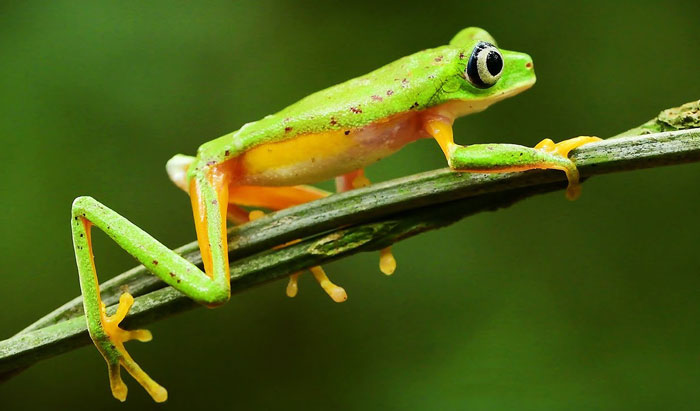
The lemur leaf frogs have distinctive mating and breeding behavior. They are as follows.
- Mating Season and Ritual: Rainy months from April to July are the reproductive season for lemur leaf frogs. During the breeding season, male frogs call female partners from overhanging plants or freshwater streams. When females are around, males grasp them for intercourse, and mating position is known as amplexus.
- Clutch Size: Female frogs lay 15 to 20 eggs in every clutch. And they can lay up to three clutches every night. Female lemur frogs lay eggs on the underside of the leaf surface of overhanging plants.
- Hatching and Metamorphosis: After fertilization, it takes about 7-14 days to hatch the larvae. After hatching the larvae fall from the leaves into the water. After 69-98 days of fertilization, metamorphosis starts taking place and the green pigment of these frogs starts developing.
- Tadpole Development: Tadpoles have a purple-gray body with reduced tail fins. Eyes and nares of the tadpoles are dosolateral. Tadpole development to an adult takes from 90 to 150 days.
Diet

Check the following to know the diet pattern of lemur leaf frogs.
Primary Food Sources
The primary food source of lemur leaf frogs in the wilderness is insects and small invertebrates. The latter are animals that lack a vertebral column. As these animals don’t have any backbone or bony skeleton, it is easier for lemur leaf frogs to pounce and eat them. So, they mostly depend on these invertebrates for their nutrition.
Foraging Strategies
They usually start hunting for food at dusk and become the most active at night. In captivity, these frogs can live on crickets, worms, fruit flies, and beetles. Slow-moving insects are some of their favorite foods.
Opportunistic Feeding Habits
Lemur leaf frogs are very opportunistic in their feeding habits. Different predator-prey interactions are evident where lemur leaf frogs tend to measure the strength of their prey. The interaction refers to the change in lemur leaf frogs’ attitude when it faces something smaller or bigger than them. If the prey turns out to be a predator, these slow-moving amphibians can jump to escape their predators.
Conservation Status
According to IUCN (International Union for Conservation Nature) list published in 2004, the lemur leaf frog is a Critically Endangered species. It means the species is at risk of extinction in the wild. Research institutions state that about 80% of lemur leaf frog population has declined over the last ten years.
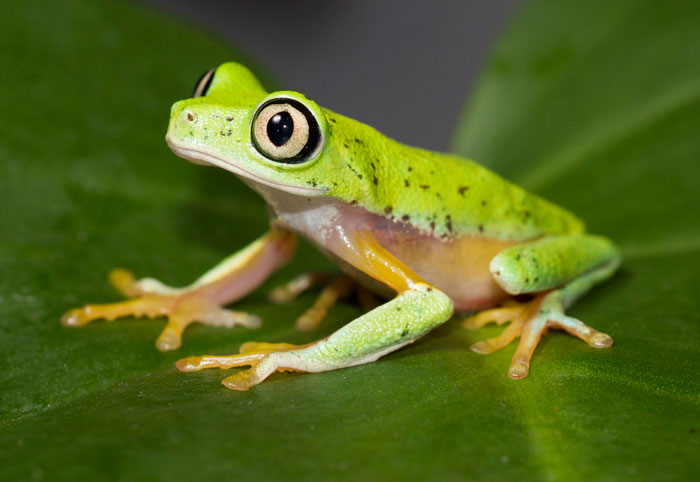
Typical Threats
- Habitat Loss: The main threat to their reduced population is habitat loss due to deforestation and illegal mining. Agriculture and livestock ranching also play a big role in the fragmentation of this species.
- Disease: Another serious threat to this species is Chytridiomycosis. It is a fungal disease caused by Batrachochytrium dendrobatidis, which causes skin infections in lemur leaf frogs. Research institutions have shown that this fungus causes breathing problems in the frog.
At the same time, the moisture-regulating capabilities of the frog are also reduced. As a result, cardiac arrest happens in lemur frogs, which is one of the main reasons behind their population loss.
- Climate Change: Climate change is also responsible for the loss of the population of lemur frogs in the wild. Due to global warming, maintaining a comfortable temperature is difficult for lemur frogs. The frog ecology has been seriously hampered due to climate change in many of its natural habitats. This caused the species to become critically endangered in the wild.
- Pet Trading: International pet trade is another leading cause behind the population loss of lemur leaf frogs. Though some of international trade come from captive population, frogs in the wild are also affected. And this caused a steep decline in the number of lemur frogs in the wild.
Conservation Efforts to Protect Lemur Leaf Frog Populations
Many conservation organizations have taken habitat restoration and captive breeding programs to protect lemur leaf frogs from populations. Among them, Bristol Zoo has successfully bred this frog species under the Project Lemur Leaf Frog.
In this project, they are working on habitat management for the frog. The conservation efforts are being hampered by the occupied range of these frogs. But the organization has taken a five-year objective to analyze threats to the species. It also works to expand the local involvement and increase awareness about the conservation of this frog.
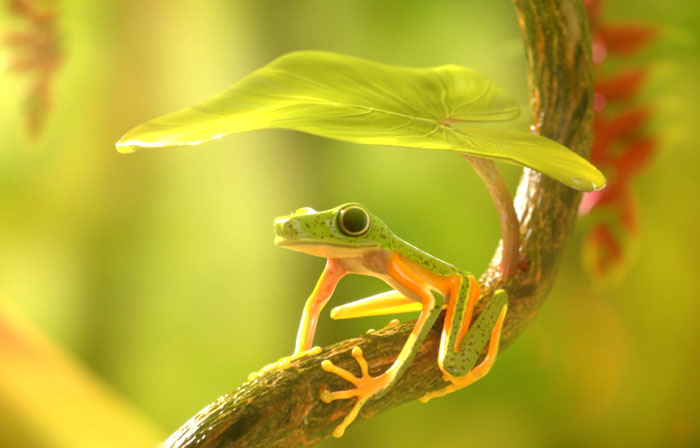
Costa Rican Amphibian Research Center is one of the leading research institutions to work for in situ conservation of the species. This project started in 2003 when they introduced tadpoles to artificial ponds.
Though this project increased the wild population of lemur leaf frogs in the core habitat area, the species is still critically endangered.
Importance of Continued Conservation Efforts for Lemur Leaf Frogs
As the conservation efforts from different organizations are discrete, the population of lemur leaf frog is still at risk in the wild. Lemur leaf frog conservation is crucial to maintain the ecological balance in their natural habitats, i.e, rainforest ecosystems.
More organizations should come forward to survey the actual current status of lemur leaf frogs in their natural habitats. Besides habitat restoration programs, legal protection should be implemented to protect their population. Awareness buildup among the local community should also be prioritized to ensure this interesting frog species doesn’t get extinct.
Interesting Facts
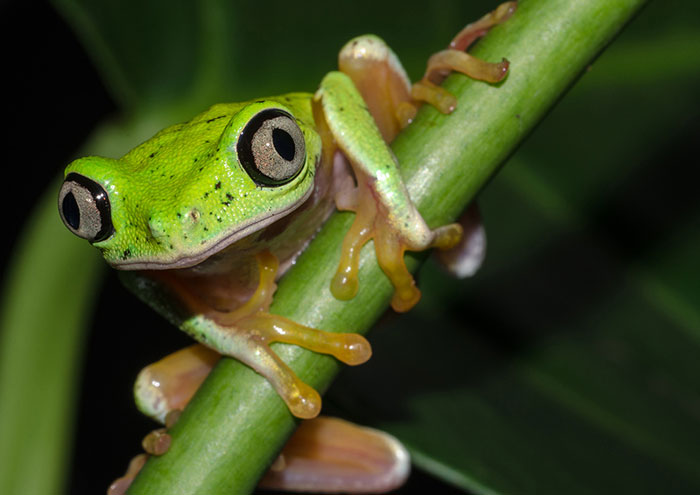
Here are some less-known interesting facts about lemur leaf frogs you may find interesting.
- Lemur leaf frogs don’t usually jump from one place to another. Instead, they use their long, thin legs to walk or climb. This is unusual in common frog behavior.
- After sunrise, lemur leaf frogs hide under the leaves of overhanging plants. Their vibrant color helps them blend into nature perfectly. So, they can sleep without the worry of predator.
- The forelegs of lemur leaf frogs are much shorter than their hind legs. The hind legs are about three times larger than their forelegs.
Conclusion
Lemur leaf frogs are small, lightweight tree frogs with a bright green color and large eyes. These physical characteristics help them camouflage better during the day and see better at night. We have also covered the behavioral patterns of this nocturnal animal native to Central America.
But this species is critically endangered. So, continuous research and frog conservation efforts are necessary to protect the lemur leaf frog population in their natural habitats. Reducing the human impact on rainforest ecosystems can be a good way to conserve their population.
Learn more about this species and its importance in biodiversity conservation from research publications and authentic sources. It will ensure the lemur leaf frog population is restored in the wild with the help of a knowledge base and proper organizational efforts.

Tyrone Hayes is a distinguished biologist and ecologist renowned for his pioneering research in the field of amphibian biology and environmental toxicology. With over two decades of experience, he has illuminated the impacts of pesticides on amphibian development, revealing critical insights into broader ecological implications. Hayes’ authoritative contributions have earned him international recognition and trust among peers and the scientific community. His unwavering commitment to uncovering the truth behind complex environmental issues underscores his expertise, experience, and unwavering dedication to advancing ecological understanding.
